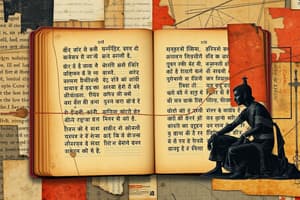Podcast
Questions and Answers
What is the primary script in which Sanskrit is written?
What is the primary script in which Sanskrit is written?
- Latin script
- Devanagari script (correct)
- Arabic script
- Cyrillic script
Which historical figure is credited with standardizing Classical Sanskrit?
Which historical figure is credited with standardizing Classical Sanskrit?
- Kalidasa
- Vishnu
- Buddha
- Panini (correct)
Which of the following is NOT a feature of Sanskrit grammar?
Which of the following is NOT a feature of Sanskrit grammar?
- Inflected nouns
- Absence of verb conjugation (correct)
- Dual number
- Flexible word order
Which significant literary work is part of the Sanskrit literary heritage?
Which significant literary work is part of the Sanskrit literary heritage?
What aspect of Sanskrit allows for a flexible word order in sentences?
What aspect of Sanskrit allows for a flexible word order in sentences?
In Sanskrit, how are adjectives treated in relation to nouns?
In Sanskrit, how are adjectives treated in relation to nouns?
What is the role of 'Sandhi' in Sanskrit?
What is the role of 'Sandhi' in Sanskrit?
What contemporary effort concerning Sanskrit is currently observed?
What contemporary effort concerning Sanskrit is currently observed?
Study Notes
Overview of Sanskrit
- Definition: An ancient Indo-European language of India, considered the liturgical language of Hinduism and a scholarly language in Buddhism and Jainism.
- Script: Primarily written in Devanagari script, but also in other scripts like Grantha, Tamil, and others.
Historical Context
- Origins: Dates back to 1500 BCE, with roots in the Vedic texts.
- Evolution: Transition from Vedic Sanskrit (used in the Vedas) to Classical Sanskrit (standardized by Panini around 400 BCE).
Importance
- Literary Heritage: Extensive body of literature including epics (Mahabharata, Ramayana), Puranas, and philosophical texts (Upanishads).
- Cultural Influence: Major influence on many languages in South Asia, including Hindi, Bengali, and others.
Grammar and Structure
- Phonetics: Rich phonetic inventory with 14 vowels and 33 consonants.
- Morphology: Highly inflected language; uses prefixes and suffixes to convey meanings.
- Syntax: Flexible word order due to case markings; typically Subject-Object-Verb (SOV).
Key Features
- Dual Number: In addition to singular and plural, Sanskrit has a dual form for two entities.
- Tenses and Moods: Eight verb forms where aspects like perfect, imperfect, and potential are expressed.
- Sandhi: Rules governing how words combine, affecting pronunciation and meaning.
Classes of Words
- Nouns: Declined for case, number, and gender (masculine, feminine, neuter).
- Verbs: Conjugated for tense, mood, voice, person, and number.
- Adjectives: Agree with nouns in gender, number, and case.
Contemporary Relevance
- Revival Efforts: Increasing interest in learning and using Sanskrit, with schools and courses emerging.
- Linguistic Studies: Significant for understanding the development of Indo-European languages.
Resources for Learning
- Textbooks: Various modern textbooks and online courses designed for beginners.
- Institutes: Institutions in India and abroad offer dedicated programs in Sanskrit studies.
Modern Usage
- Literature and Poetry: Continued creation of new literature and adaptations of ancient texts.
- Spiritual Practices: Used in rituals, chants, and philosophical discussions in Hindu traditions.
Overview of Sanskrit
- Ancient Indo-European language of India, integral to Hinduism and significant in Buddhism and Jainism.
- Primarily written in Devanagari script; alternative scripts include Grantha and Tamil.
Historical Context
- Originates around 1500 BCE with foundations in the Vedic texts.
- Transitioned from Vedic Sanskrit, found in the Vedas, to Classical Sanskrit, standardized by the grammarian Panini around 400 BCE.
Importance
- Rich literary heritage, featuring epic stories like the Mahabharata and Ramayana, along with philosophical texts such as the Upanishads.
- Major impact on South Asian languages, including Hindi and Bengali, highlighting its cultural significance.
Grammar and Structure
- Phonetic system comprising 14 vowels and 33 consonants, showcasing complexity.
- Highly inflected language using prefixes and suffixes for meaning enhancement.
- Flexible syntax due to case markings; commonly follows Subject-Object-Verb (SOV) order.
Key Features
- Includes a dual form for nouns, alongside singular and plural.
- Verb forms encompass eight tenses, expressing various aspects including perfect and potential.
- Sandhi rules dictate word combination practices, influencing both pronunciation and meaning.
Classes of Words
- Nouns are declined based on case, number, and gender (masculine, feminine, neuter).
- Verbs change form through conjugation, adapting to tense, mood, voice, person, and number.
- Adjectives must agree with nouns in terms of gender, number, and case.
Contemporary Relevance
- Growing interest in Sanskrit education, with new schools and courses developed for learners.
- Critical for linguistic studies, contributing to a deeper understanding of Indo-European language evolution.
Resources for Learning
- A variety of modern textbooks and online courses available, catering to beginners.
- Dedicated programs in Sanskrit offered by institutions across India and internationally.
Modern Usage
- New literary works and adaptations of traditional texts continue to emerge in Sanskrit.
- Utilized in spiritual contexts, including rituals, chants, and philosophical discourse within Hindu traditions.
Studying That Suits You
Use AI to generate personalized quizzes and flashcards to suit your learning preferences.
Description
Explore the fascinating world of Sanskrit, an ancient language with deep historical roots and rich literary heritage. This quiz covers its origins, evolution, grammar, and its significant cultural influence across South Asia. Test your knowledge on this scholarly language used in Hinduism, Buddhism, and Jainism.




